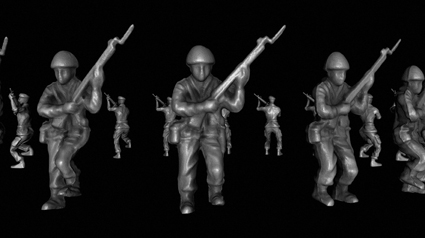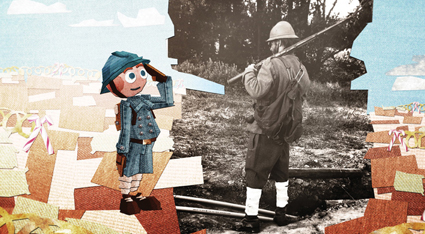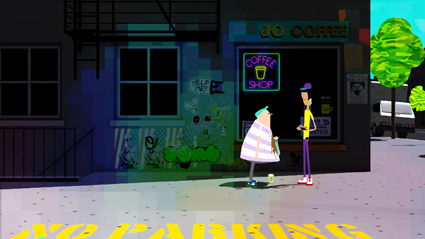international animation: the bleak & the upbeat
katerina sakkas: international program, uts sydney animation festival

Spin, director Max Hattler
THE PENDULUM SWUNG BETWEEN WHIMSY AND TRAGEDY IN THE INTERNATIONAL PROGRAM OF SHORT FILMS AT THIS YEAR’S UTS SYDNEY INTERNATIONAL ANIMATION FESTIVAL CURATED BY ANIMATORS (AND UTS LECTURERS) DEBORAH SZAPIRO AND DAMIAN GASCOIGNE.
With a couple of exceptions, this was a strong selection of films, and one which encompassed a great variety of techniques, including drawn animation, glass painting, stop-motion, 2D digital animation and CGI. Despite the stylistic diversity, certain common themes emerged. Most work was narrative-based (other programs in the festival concentrated on abstraction), though some films depended more on mood than story. Three out of the four French shorts had an anti-war message, while several films explored isolation. The idea of escape ran through films both bleak and upbeat. What better medium, after all, to illustrate the concept of escape than animation—a medium in which objects and scenes transform with the greatest of ease.
Journey to Cape Verde (Portugal, 2010) explores the popular escape sought through travel, following a harried city worker who leaves for the unsullied splendour of Cape Verde, an archipelago off the west coast of Africa. Senses dazzled, the viewer is pulled into the world of the solitary traveller as he moves through striking terrain, experiences local hospitality and is generally exposed to the small discomforts and larger rewards of the journey. Mainly employing simplified silhouettes of intense colour, deliberately redolent of African painting, the film is one of several in the program to create textural variety through a mixture of animation styles, including drawn sketchbook images that occasionally ‘come alive.’ It’s a testament to director Jose Miguel Ribeiro’s skill that he conveys such a strong sense of place in this work, as well as reminding us of travel’s capacity to broaden our horizons, literally and figuratively.

La Detente, directors Pierre Ducos, Bertrand Bey
Most of the films exploring the escape theme were darker than this, however, their versions exploring the escape offered by imagination in the face of unpalatable reality. In La Detente (France, 2011) a soldier in the trenches of WWI dreams up a marvellous fairground battlefield populated by toy soldiers led by his own alter ego. This is expertly depicted in full-blown Pixar-style 3D animation which moves with relentless jollity. There are shades of The Wizard of Oz as the diminutive toy hero enters a giant head-shaped fortress, at which point the narrative takes a darker turn. It’s interesting to see this wide-eyed, cute-as-a-button imagery employed in a film about death and destruction, though directors Pierre Ducos and Bertrand Bey over-egg the pudding somewhat, their fantasy world a little too incompatible with the ‘real’ world of the soldier.
Being Bradford Dillman (UK, 2011) sees a small girl summon up an imaginary friend, who is also an alter ego of sorts, in response to a spiteful joke made by her mother. Molly Flowers, the young protagonist, is lonely: neglected by her alcoholic mum and teased by the neighbourhood kids. The film creates a child’s view of the world through cutout animation suggestive of children’s book illustrations, with the top of the mother’s head never seen. Its big-headed, enormous-eyed characters are more haunted than cute, however, and as if to reflect the lack of real joy in this child’s world, the colours are pallid and washed out. Being Bradford Dillman is wryly funny, but ultimately rather bleak.
The same can be said of Moxie (UK, 2011), which documents the last days of a psychopathic, suicidal bear. The creation of idiosyncratic animator Stephen Irwin, the film possesses the smudged black and white quality of an ancient crime scene photograph. It’s a tragicomic perversion of children’s animation narrated (by Ragga Gudrun) in a gentle Icelandic accent. Intriguing in some ways, it feels at the same time rather conceptually facile. Sharing the darker end of the spectrum, The Backwater Gospel (Denmark, 2011) is an atmospheric Gothic Western about the increasingly murderous paranoia which envelops the grizzled denizens of a desert hamlet. The creation of eight students at Denmark’s Animation Workshop, it’s as richly delineated as a classic superhero graphic novel—a celebration of genre rather than an attempt to break new ground. But the film to tackle death and destruction most succinctly was Spin (France, 2011). Simpler and more cogent than La Detente, its fellow French anti-war film, Spin offers up intricate patterns of digitised toy soldiers, presented Busby Berkeley-style. This frivolous dance of death mesmerises, emphasising through obscene parody the production line character of war.
Animation excels at mucking around with reality and delighting in the impossible. Several films played most successfully with this aspect of the medium. Luminaris, (Argentina, 2011) is a whimsically picturesque short in the vein of Amélie (2001), where real-life actors move in Chaplinesque stop-motion as they go about creating a wondrous new energy source. Da Haus (Germany, 2011) is an absurdist elaboration on the idea of creating one’s world from the ground up—an apt metaphor for the animation process itself, and one that was also explored in The Back Room (Austria, 2011). Yonalure: Moment to Moment (Japan, 2011), in which the moon takes a curious stroll through a slumbering town, shares something of Da Haus’s absurdist quality as well as its use of simplified shapes. In a dreamlike sequence that plays with notions of scale, the moon alternately grows and shrinks, pulling all objects towards it as it explores this new environment—only to wind up dissolving in a bottle of soft drink.

A Morning Stroll, director Grant Orchard
It seems fitting to conclude with a film that pays sophisticated homage to the animation medium itself. Inspired by a New Yorker story, A Morning Stroll (UK, 2011) begins in 1950s New York, which is rendered in the economical lines characteristic of cartoons from the famous literary magazine. It presents us with a mystery: a chicken walks unconcernedly along the city street, mounts the steps of a brownstone, pecks at the door and is let in by an unknown person, all to the bemusement of a passerby. Jumping forward 50 years, we’re taken through an almost identical scenario, this time in vividly coloured 2D digital animation. A young witness tries to document the chicken’s behaviour on his cellphone but, distracted by a zombie app, misses his opportunity. This leads us into the post-apocalyptic final instalment, a scene of desolation depicted in immersive 3D, where the passerby is a zombie and the stroll becomes a frenzied pursuit. For its wit and technical dexterity in charting the evolution of animation styles, A Morning Stroll was my pick of the bunch.
I would hazard a guess that for many adults, animation is inextricably linked to childhood. Most films in the International Program seemed to acknowledge this, either through playfulness, anthropomorphism or the telling of children’s stories. They used these signifiers, however, to express an often disturbing, adult sensibility.
UTS Sydney International Animation Festival: International Program, Sydney, Oct 13-14
RealTime issue #112 Dec-Jan 2012 pg. 21






